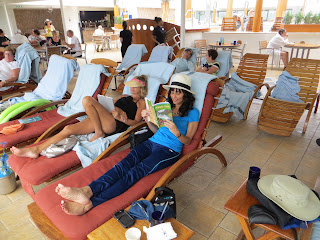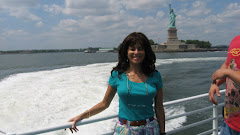Lima, Peru--December 17, 2012 in port 7AM-6PM
Our ship docked at theport of Callao (pronounced Kay-ya-oh), seven miles from central Lima and 10 miles from Miraflores.
I decided to take the Celebrityship’s (9:20AM) $12.50 round trip shuttle transfer to Miraflores hoping to catch a quick taxi from there to visit the historic UNESCO district in old town and a museum or two.
I discovered that traffic in Lima is atrocious!! It takes 45-60 minutes to go anywhere. Because of traffic congestion, it took us almost an hour to go 10 miles to Miraflores. I was told that navigating Lima is a complicated, time consuming task, made difficult by its sprawling character, heavy traffic, pollution, and chaotic network of confusing local transportation. Taxis are cheap but unregulated.
We arrived in Miraflores at 10:45AM. Miraflores is modern, with high-rises and American-esque shops along the waterfront. Although it is pretty, it does not look Peruvian. I found nothing of interest here. So I decided to join a couple I met on the shuttle (Sema and Milton from NJ), in negotiating with a taxi driver/tour guide, Mauro, to take us to visit colonial Lima.
We agreed to pay him $40 for a 2-hour tour. I paid $13 + 5 tip. We left at almost 11:00.
We were fortunate that he was personable, knowledgeable, patient, and spoke English well. He had lived in the US for a while.
Once again, we were surprised that traffic congestion made a short distance last for almost an hour to reach the city center. We passed the Plaza San Martin, Lima's grandest European-style square, en route.
Our first stop was a parking lot to relieve us of the vehicle. That enabled us to explore old town on foot. Our first stop was the gem of Central Lima: Convento y Museo de San Francisco, a baroque church with a serene courtyard, impressive neo-classical alter, 17th century library, breathtaking carved Moorish ceiling, and 1546-era catacombs. Nearby, was a great view of the Puenta de Piedra (stone bridge) with spectacular back drop of multicolored houses on mountainside villages across the river Rimac.



Next, we hastened to the Plaza de Armas (also known as the Plaza Mayor) to witness the noon changing of the guard ceremony. There was excitement in the air and throngs of tourists photographed the ceremony up close. I observed that the city's historic center has a generous share of Baroque, Renaissance, and Rococo-inspired buildings with elaborate facades, balconies, ornate gates and courtyards in the area around the Plaza Mayor.
The central bronze fountain survives from 1651, despite disastrous earthquakes that devastated the city. We looked from outside at the Cathedral and Archbishops Palace. Next time, I might go inside.
We strolled for a half an hour and even bargained for inexpensive souvenirs from street sellers. (They have neat items at great prices)
Lima has some of the most attractive wares as it is known for colorful markets that display a dazzling array of alpaca wool sweaters, blankets, ponchos, shawls, scarves, purses, hats and other woven items. Reproductions of Peru’s ancient civilizations’ ceramics are also abundant. The markets here are truly a feast for the eyes!
Mauro dropped us off at Miraflores at 1:10, making a stop along the way at an archeological site with llamas. Yes, we saw llamas in Lima!
I strolled around the waterfront mall then, took the 1:45 shuttle back to the port. There were at least 30 merchants selling gorgeous traditional Peruvian items at reasonable prices.
Next time, I will visit some of Peru’s famous museums.
Note: There are 2 port drop offs. One has a nice Indian market; the other is 5 minutes away in “no man’s land”. If they take you to the “dead port”, go to the other port for taxis to old town and for shopping.


















































.jpg)
.jpg)



